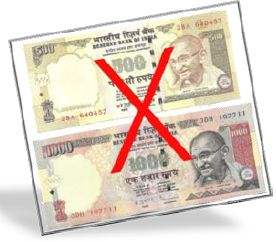More black-money could be collected from 8 lakh ‘farmers’ than through demonetisation
The demonetisation drive of the Narendra Modi government is expected to flush out black money. By demonetising Rs 500 and Rs 1000 notes, the government has rendered illegal 86 percent of the currency in circulation, totaling Rs 14.2 lakh crore.
Most analysts believe that after the demonetisation drive is over, and the last date of December 30 has been crossed, the RBI may actually find that 30 percent of the Rs 14.2 lakh crore did not get deposited in banks. Thus, this would be the money that could not get laundered.
In effect, the entire demonetisation drive is expected to achieve two concrete results. First, it would allow the RBI to write off Rs 5 lakh crore, and thus reduce the quantum of black money floating around in cash by the same amount. Second, it would get around Rs 9 lakh crore into bank deposits. The government’s expectation is that this money could be harnessed for productive purposes, and the black money ogre would have been controlled.
Really?
Figures that are already in public domain show that the entire demonetisation exercise could have been avoided. The government could have unearthed a lot more black money and filled its coffers with much more money had it just followed up on the accounts filed by around 8 lakh assessees (http://www.asiaconverge.com/2016/07/indias-biggest-laundromat-agriculture/).
Who are the 8 lakh assessees? Just look at the table below, and you will see how the number of people who filed income tax returns declaring agricultural income swelled from 2.46 lakh assesssees in 2009 to 4.25 lakh in 2010 to 6.56 lakh in 2011 and then to 8.12 lakh people in 2012. The “agricultural income” bit is extremely important, because all agricultural income is totally exempt from income tax [Note: a lakh equals 100,000; a crore equals 10 million; hence a lakh crore equals one trillion].
Since many of the assessees of 2009 are also likely to have filed their returns in the subsequent years, one can safely assume that the total number of assessees whose returns need to be examined will be just around 8 lakh.
But who are these 8 lakh people? That is something we do not know. All that we know is that the total income declared by them in 2011 and 2012 was a stupefying Rs 874 lakh crore. That represents over 125 years of total taxes garnered by the government in any given year. The average income declared by each assessee during those years was an equally unbelievable Rs 30 crore and Rs 80 crore respectively. Obviously, even if you take the most fertile land with the most expensive crop, average incomes of Rs 80 crore are not easy to come by. Something is amiss.
Even if one assumes that only 30 percent of the amounts declared were roped in as taxes, the government would have got Rs 262 lakh crore. That would have been higher than the Rs 5 lakh crore the government hopes to impound as black money and the Rs 9 lakh crore it hopes to garner by way of incremental deposits.
What this means is that instead of pursuing 8 lakh people, the government decided to target 1.25 billion people.
In fact, the entire saga of these agricultural income declarations would not have come to light, had it not been for an RTI request filed by the former I-T officer.
The retired Income Tax (I-T) officer – Vijay Sharma – decided to file an RTI (Right to Information) request for disclosing the names of people who had filed agricultural income returns for (you won’t believe this) Rs 2,000 lakh crore. The figures he got showed an exponential increase from 2004 to 2013, touching a total of almost Rs 2,000 lakh crore. He then asked the income department to release the names of the top 100 names of the people who had filed such returns. His request was denied. He then decided to file a public interest litigation (PIL) petition with the Patna High Court in Bihar. This matter was duly reported by media in March 2016. The court was supposed to hear the petition in April this year. But there is no further news from that front.
Almost simultaneously, the Income Tax Department gave out a different set of figures (see table) which was dutifully reported by the media.
More interestingly, on 10 March 2016, the IT department sent out a circular http://taxguru.in/income-tax/verification-agriculture-income-1-crore.html The circular number was LETTER F.NO.DGIT(S)/DIT(S)-3/AST/PIL MATTER/AGRICULTURAL INCOME/97/2015-16. It was sent to all its offices stating the following: It can also be downloaded from 2016-03-10_Tax-guru-laundromat-Verification of Agriculture Income. I
It stated:
“Kindly refer to subject matter.
2. It has been noticed that several assesses have declared income from agriculture of more than Rs 1 crore in the income tax return filed for earlier years especially from AYs. 2011-12 to 2013-14.
3. In this regard, there is a PIL matter pending before Hon’ble Patna High Court wherein concerns have been raised that a few assesses may be engaged in routing their unaccounted/illegal money in the garb of agricultural income thereby not only claiming exemptions on such income but also engaged in the money laundering activities.
4. Since agricultural income is only used for rate purposes, it was noticed that in a few such high value cases, taxpayers may have inadvertently made data entry errors while filling up the fields for agricultural income.
5. Therefore, it is requested that the assessing officers may be directed to
(i) Verify whether the taxpayer may have made a data entry error while filling up the return.
(ii) Wherever scrutiny assessment is completed, AO may provide feedback based on assessment records.
(iii) In cases where proceedings u/s 143(3) are pending, assessing officers may be informed to thoroughly verify the claims.
6. The list of cases having agriculture income more than Rs.1 Crore along with jurisdictional details is placed at itaxnet at the following path :
Resources Downloads Systems Verification of Agriculture-Income
You are requested to kindly send a status report in this regard after verification as mentioned above. This feedback may be urgently provided to this Directorate before March 20th, 2016 so that we can report the correct figures of claims of agricultural income to the Hon’ble Patna High Court.
7. This issues with the approval of Pr. DGIT(S).
To date, there has been no further information on this subject. Nor is it known whether the declarations are indeed agricultural income, or whether they have sought refuge under the “taxpayers may have inadvertently made data entry errors.”
The only statement was one made by Union agriculture minister Radha Mohan Singh in the last week of May 2016, that there is no plan to tax agricultural income. And just yesterday, while addressing a rally of farmers in Maharashtra, Prime minister Modi also reiterated that there would be no tax on agricultural income.
But that raises two questions. First, do the returns filed actually represent agricultural income? Should the onus of proving that it is indeed agricultural income rest on the assessees since there were voluntary returns filed by them? Second, if they are mis-declarations, shouldn’t the minimum tax of 30 percent be levied on them along with applicable penalties as well?
The government is silent. So is P. Chidambaram, who was minister of finance at the time these huge amounts were declared as agricultural income. As a result all people suffer from the consequences of demonetisation that could have been avoided by just targeting some 8 lakh people.
Sources:
http://taxguru.in/income-tax/
http://www.firstpost.com/
http://www.s3solutions.in/f-
http://news-express.in/news/
http://www.business-standard.
http://timesofindia.
http://m.thehindu.com/news/
http://www.thequint.com/india/
http://timesofindia.












































COMMENTS